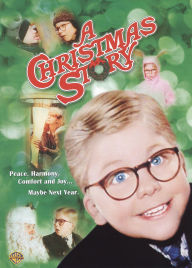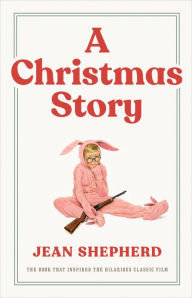13 Things You Never Knew About A Christmas Story (The Book!)

A Christmas Story
A Christmas Story
Cast
Jean Shepherd
,
Paul Zaza
,
Carl Ziffrer
,
Peter Billingsley
,
Darren McGavin
,
Melinda Dillon
,
Ian Petrella
Director
Bob Clark
In Stock Online
DVD $19.99
Christmas is a season of joy and peace. A season when people actually put eggnog and fruitcake on the menu. It’s also a season for endless reruns of A Christmas Story, the low-budget, 1983 movie that became a quirky Yuletide classic. Movie fans may think they know the whole story of Ralph Parker and his quest for a Red Ryder B.B. gun—or, more precisely, a carbine-action, 200-shot, range-model air rifle, “with a compass in the stock, and this thing which tells time.” But no one can claim expert status who hasn’t read the book. Believe it or not, Jean Shepherd’s ode to home, hearth, and small-town Americana first appeared in (gasp!) Playboy magazine. In 1966, it was published as a collection of stories, under the title In God We Trust: All Others Pay Cash. And later, it was reissued as a book, A Christmas Story.
Christmas is a season of joy and peace. A season when people actually put eggnog and fruitcake on the menu. It’s also a season for endless reruns of A Christmas Story, the low-budget, 1983 movie that became a quirky Yuletide classic. Movie fans may think they know the whole story of Ralph Parker and his quest for a Red Ryder B.B. gun—or, more precisely, a carbine-action, 200-shot, range-model air rifle, “with a compass in the stock, and this thing which tells time.” But no one can claim expert status who hasn’t read the book. Believe it or not, Jean Shepherd’s ode to home, hearth, and small-town Americana first appeared in (gasp!) Playboy magazine. In 1966, it was published as a collection of stories, under the title In God We Trust: All Others Pay Cash. And later, it was reissued as a book, A Christmas Story.
A Christmas Story: The Book That Inspired the Hilarious Classic Film
A Christmas Story: The Book That Inspired the Hilarious Classic Film
In Stock Online
Hardcover $18.00
Ready to test your Christmas Story smarts? Take this quiz on the differences between the book and the film—we double-dog-dare you.
- What’s the name of Ralphie’s homeroom teacher?Answer: In the movie, it’s Miss Shields who assigns the theme, “What I Want for Christmas,” inspiring Ralphie’s rapturous ode to Red Ryder and his “peacemaker.” In the book, Ralphie’s teacher is Miss Iona Pearl Bodkin. (Miss Shields does make a cameo appearance at Warren G. Harding School, however.)
- Who is the neighborhood bully?
Answer: In the movie, of course, it’s yellow-eyed Scut Farkus, of the wicked grin and coonskin cap. In the book, the real bad guy is Scut’s second-in-command, Grover Dill. Described as “a puff adder among garden worms,” Grover Dill is “a sneevily, snively bully…with the kind of aggression that is later called talent or drive.” It’s Grover who becomes the recipient of Ralphie’s big beat-down—a scene that’s provided vicarious bliss to generations of picked-on kids. - What does Aunt Clara send Ralphie for Christmas?
Answer: No, it’s not a Pepto-pink, head-to-toe bunny suit. But for Ralphie, it’s almost as humiliating to get a pair of “fuzzy, pink, idiotic, cross-eyed, lop-eared bunny slippers.” What does Aunt Clara think—that he’s a girl?!
Ready to test your Christmas Story smarts? Take this quiz on the differences between the book and the film—we double-dog-dare you.
- What’s the name of Ralphie’s homeroom teacher?Answer: In the movie, it’s Miss Shields who assigns the theme, “What I Want for Christmas,” inspiring Ralphie’s rapturous ode to Red Ryder and his “peacemaker.” In the book, Ralphie’s teacher is Miss Iona Pearl Bodkin. (Miss Shields does make a cameo appearance at Warren G. Harding School, however.)
- Who is the neighborhood bully?
Answer: In the movie, of course, it’s yellow-eyed Scut Farkus, of the wicked grin and coonskin cap. In the book, the real bad guy is Scut’s second-in-command, Grover Dill. Described as “a puff adder among garden worms,” Grover Dill is “a sneevily, snively bully…with the kind of aggression that is later called talent or drive.” It’s Grover who becomes the recipient of Ralphie’s big beat-down—a scene that’s provided vicarious bliss to generations of picked-on kids. - What does Aunt Clara send Ralphie for Christmas?
Answer: No, it’s not a Pepto-pink, head-to-toe bunny suit. But for Ralphie, it’s almost as humiliating to get a pair of “fuzzy, pink, idiotic, cross-eyed, lop-eared bunny slippers.” What does Aunt Clara think—that he’s a girl?!
In God We Trust: All Others Pay Cash
In God We Trust: All Others Pay Cash
In Stock Online
Paperback $17.00
Answer: In the movie, it’s Higbees department store in downtown Cleveland, which first opened in the 1890s, and provided the backdrop for some of the movie scenes. In the book, however, Ralphie meets St. Nick at a store called Goldblatt’s. (Extra-credit trivia: The real Higbees is still around, but is now a casino!)
Answer: In the movie, he simply sends in an Ovaltine wrapper. In the book, alas, poor Ralphie comes from a “non-Ovaltine-drinking neighborhood.” Then, while playing “Kick the Can,” he is thrilled to find an Ovaltine jar in the trash. Only then is Ralphie inducted into Annie’s inner sanctum.
Answer: In the movie, you see three or four at most. In the book, there are not only 1,000 Bumpuses, but 745 slobbering mongrels! There must be a population explosion along the way, because later, the pack increases to more than 4,000 yelping hounds. (Extra-credit trivia: All the dogs are named Old Blue, Big Red, or Luke!)
Answer: In the movie, it’s the Christmas turkey. In the book, it’s the Easter ham, glazed with brown sugar and molasses, and decorated with pineapple slices. (For the record, the dogs take eight seconds to devour it.)
Answer: You guessed it—the Old Man takes everyone to a chop suey joint. As Shepherd writes, dinner at a Chinese restaurant is usually “a gala of the highest order.” But unlike the movie, the dinner scene in the book is a joyless affair, in which not a word is spoken, much less a rousing rendition of “Deck the Halls.”
Answer: You probably guessed this one—the scene in the schoolyard, where Flick gets his tongue stuck to a telephone pole. (Careful, kids, this really hurts!) Another missing scene: the one where Ralphie drops the lug nuts, utters “the Queen Mother of all dirty words,” and later gets a mouthful of Lifebuoy.
Answer: The Bumpuses are minor figures in the movie, but loom large in the book, and are as much a torment for Ralphie’s Old Man as that balky basement heater. Then, one day, they suddenly vanish—and their mangy dogs, too—to be replaced by a nice old couple who soon have the house “looking like an illustration for an insurance company.”
Answer: Walgreen’s!
Answer: You have to read the book for this one: A rubber Frankenstein face, and a “Sandy Andy” toy gravel loader.
Answer: In the book, it’s the 1930s. In the movie, it’s the 1940s. But really, folks, A Christmas Story is timeless.
How many times have you seen A Christmas Story?
Answer: In the movie, it’s Higbees department store in downtown Cleveland, which first opened in the 1890s, and provided the backdrop for some of the movie scenes. In the book, however, Ralphie meets St. Nick at a store called Goldblatt’s. (Extra-credit trivia: The real Higbees is still around, but is now a casino!)
Answer: In the movie, he simply sends in an Ovaltine wrapper. In the book, alas, poor Ralphie comes from a “non-Ovaltine-drinking neighborhood.” Then, while playing “Kick the Can,” he is thrilled to find an Ovaltine jar in the trash. Only then is Ralphie inducted into Annie’s inner sanctum.
Answer: In the movie, you see three or four at most. In the book, there are not only 1,000 Bumpuses, but 745 slobbering mongrels! There must be a population explosion along the way, because later, the pack increases to more than 4,000 yelping hounds. (Extra-credit trivia: All the dogs are named Old Blue, Big Red, or Luke!)
Answer: In the movie, it’s the Christmas turkey. In the book, it’s the Easter ham, glazed with brown sugar and molasses, and decorated with pineapple slices. (For the record, the dogs take eight seconds to devour it.)
Answer: You guessed it—the Old Man takes everyone to a chop suey joint. As Shepherd writes, dinner at a Chinese restaurant is usually “a gala of the highest order.” But unlike the movie, the dinner scene in the book is a joyless affair, in which not a word is spoken, much less a rousing rendition of “Deck the Halls.”
Answer: You probably guessed this one—the scene in the schoolyard, where Flick gets his tongue stuck to a telephone pole. (Careful, kids, this really hurts!) Another missing scene: the one where Ralphie drops the lug nuts, utters “the Queen Mother of all dirty words,” and later gets a mouthful of Lifebuoy.
Answer: The Bumpuses are minor figures in the movie, but loom large in the book, and are as much a torment for Ralphie’s Old Man as that balky basement heater. Then, one day, they suddenly vanish—and their mangy dogs, too—to be replaced by a nice old couple who soon have the house “looking like an illustration for an insurance company.”
Answer: Walgreen’s!
Answer: You have to read the book for this one: A rubber Frankenstein face, and a “Sandy Andy” toy gravel loader.
Answer: In the book, it’s the 1930s. In the movie, it’s the 1940s. But really, folks, A Christmas Story is timeless.
How many times have you seen A Christmas Story?


